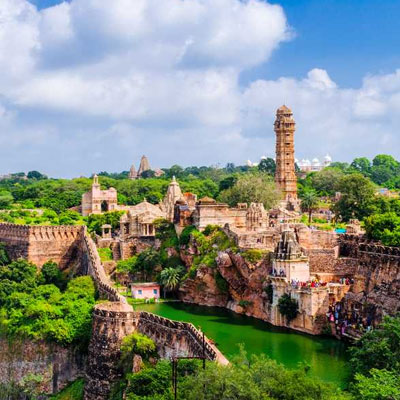Exploring the Valor of Rajputs: The Historical Significance of Chittorgarh Fort
Rajasthan, celebrated for its bravery, sacrifice, and pride, is epitomized by the legendary Chittorgarh Fort. This historic site stands as a testament to the courage of the Rajputs, echoing tales of their valor and resilience. Chittorgarh has witnessed numerous traumatic events, starting with Alauddin Khilji's first seizure of the fort in 1303, motivated by his desire to capture Queen Padmini. In the following centuries, Bahadur Shah and Mughal Emperor Akbar also seized the fort, with it being restored to the Rajputs in 1616 under Mughal ruler Jahangir. Perched on a 180-meter-high hill and spreading over 240 hectares, Chittorgarh Fort is a symbol of the Rajputs' audacious past. Associated with the legendary hero Bhim, one of the five Pandavas, it is adorned with majestic monuments that embody the unyielding spirit of its history, filled with scars that narrate tales of warcraft and courage. Rani Padmini’s Palace: Located beside the Lotus Pool, Rani Padmini’s Palace is pivotal in Chittorgarh’s history. It was here that Alauddin Khilji first glimpsed Rani Padmavati. Tower of Victory (Vijay Stambh): Erected by Maharana Kumbha between 1440 and 1448 AD to celebrate victories over Malwa and Gujarat's rulers, this nine-story tower made of redstone and sandstone boasts mythological depictions of Hindu Gods and Goddesses. Climbing its narrow steps offers a panoramic view of the entire town. Jain Temples and Kirti Stambh: Within its fort complex, Chittorgarh Fort houses six Jain Temples, the largest being the Bhagawan Adinatha Temple. Nearby, the Kirti Stambh, or Tower of Fame, dedicated to Adinathji, the first Jain Tirthankara, was built by a wealthy Jain merchant in the 12th century. Fateh Prakash Palace: Originally Maharana Fateh Singh's residence, this palace now serves as a museum housing treasures like Bassi village's wooden crafts and artifacts from local warriors and citizens. Kalika Mata Temple: Initially dedicated to the deity Kali in the 14th century, the Kalika Mata Temple now worships the Sun God and remains a symbol of valor and power. Winter is the ideal time to visit Chittorgarh, with manageable temperatures. Summers can see temperatures rise to 42 degrees Celsius, while monsoons bring moderate showers, cooling the air to a pleasant 25 degrees Celsius. Rail: Chittorgarh Railway Station is situated along the banks of the river Ghamberi. Road: Chittorgarh is well-connected by frequent bus services to various states in Rajasthan, with autorickshaws available for local travel. Air: The nearest airport is in Dabok, 98 km from Udaipur. What is the best time to visit Chittorgarh? The best time to visit Chittorgarh is during the winter months, from October to March, when temperatures are manageable. How can I reach Chittorgarh by air? The nearest airport is in Dabok, 98 km from Udaipur. What are the main attractions at Chittorgarh Fort? Key attractions include Rani Padmini’s Palace, Vijay Stambh, Jain Temples, Kirti Stambh, Fateh Prakash Palace, and Kalika Mata Temple. What is the historical significance of Chittorgarh Fort? Chittorgarh Fort is a symbol of the Rajputs' bravery and resilience, having endured numerous traumatic events and conquests over the centuries. What is unique about the Kirti Stambh in Chittorgarh? The Kirti Stambh, dedicated to the first Jain Tirthankara Adinathji, was built by a wealthy Jain merchant in the 12th century and is adorned with intricate carvings. 
Historical Significance of Chittorgarh Fort
The Magnificent Chittorgarh Fort
Key Attractions in Chittorgarh
Climatic Conditions
Ways to Reach Chittorgarh
FAQs